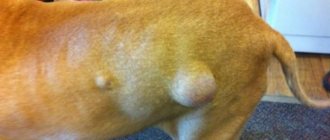What should we do then?
The first step is to have a heart-to-heart talk with your veterinarian. This may not be easy, but it is very important.
You and your veterinarian will need to answer difficult questions such as:
- What is my pet's diagnosis?
- Why is my pet hurt?
- How can we reduce pain?
- Can medications help?
- Can surgery help?
For example, if your dog is limping, pain medications, joint supplements, weight loss, or a "co-diet" may help...
Pros and cons of euthanizing animals
If you find yourself in such a difficult situation, try to put aside your feelings and act rationally. First of all, it is recommended to evaluate the main advantages and disadvantages. The first include:
- ridding the dog of unbearable physical suffering;
- painlessness and speed of death;
- the opportunity to be there at the last moment and have time to say goodbye;
- the possibility of organizing euthanasia under the supervision of a veterinarian right at home.
There are much fewer cons. There are only two of them: the difficulty of making a difficult decision and the relatively high cost of the procedure.
How to Know When Your Pet's Quality of Life is Deteriorating
Isn't this subjective? Doesn't it depend on your personal beliefs? How can you be objective given the close bond you have with your pet?
One fairly objective and simple way to determine your pet's quality of life is to use a scale from 1 to 10:
- 1 means the lowest quality of life.
- 10 is the best possible quality of life.
If you gave your pet a 9 in January, a 7 in March, and a 5 in May, it's time to face the truth: your pet's quality of life has declined significantly in a short period of time.
You need to have an honest conversation with your family and veterinarian about what can realistically be done.
What happens after euthanasia
According to the legislation of the Russian Federation, in Russia dead pets are equated to biological waste. The thing is that when a corpse decomposes, all the bacteria and toxins it contains enter the soil. Through it they easily reach groundwater, which is fraught with mass infection of people and other animals.
In order to prevent dangerous viral infections, it is strictly prohibited to perform the following actions:
- bury the remains in the ground;
- throwing bodies into bodies of water;
- throw corpses into a trash container or landfill.
All of the above threatens with a fine of 4-5 thousand rubles, but in order to collect it, the violation must be recorded. Despite this, you should not do everything quietly and ignore existing rules and recommendations.
The only legal method of burial is cremation. The corpse is burned either in a common oven or individually. In the first case, the urn containing the ashes will contain the remains of other animals. After receiving it, the following options are allowed:
- bury the urn in your personal burial plot or pet cemetery;
- rent a cell in any human columbarium;
- leave the ballot box at home;
- scatter the ashes in any place other than public.
It is important to understand that when placing an urn in a pet cemetery there is a high risk of it being disposed of. Such places are illegal, so periodically all buried corpses are dug out from there and burned. Despite this, there are exceptions in some cities. For example, in St. Petersburg there is an official city cemetery, created with the assistance of the government.
“ More about burying dogs
When euthanasia becomes an option
The next task is to remember that age is not a disease.
If neither pain relief nor medical and surgical treatment can help, it may be time to consider euthanasia.
© shutterstock
As difficult as it may be emotionally and ethically for you, your entire family, your veterinarian and their staff, euthanasia is sometimes the only reasonable and humane solution. This may be the only way to relieve your pet's condition.
For a pet, quality of life includes the right to end suffering with dignity when all reasonable options have been exhausted.
What is euthanasia – and is it humane?
Euthanasia is a completely humane way of dying without pain through the administration of special drugs. Despite the criticism, it should in no way be equated with animal cruelty.
REFERENCE!
Translated from ancient Greek, euthanasia means “good death.”
In medicine, the decision is made by the person who will be euthanized, but in veterinary medicine, it is solely the pet’s owner. Therefore, the decision is much more difficult, because we cannot find out the opinion of the four-legged animal itself. Despite this, there are certain indications for the procedure, without which the veterinarian has every right to refuse to perform it.
When is it time to put your dog to sleep?
Most pet parents will eventually face the most difficult decision: whether or not to euthanize their dog.
Each journey of pet loss is unique. There are so many factors that go into end-of-life decisions.
Again, try to take yourself out of the equation and think about this day in the life of your pet:
- Is there joy?
- Is there any interest?
- Is it possible to perform any action?
- Is there quality?
- Is there...life?
While most wish their furry family members would simply “sleep away,” this almost never happens.
There are times when an owner, on the advice of a veterinarian, has to decide whether to euthanize a dog. It is very difficult to do this; many people prefer to care for their four-legged pet until the last moment, waiting for its natural death. But admit to yourself that saving the life of a suffering, hopelessly ill animal for the sake of your own peace of mind and clearing your conscience is selfish. Here we will touch upon such a sensitive topic as euthanasia. I really hope that the following information will help owners of elderly or terminally ill dogs in making difficult decisions and will help many animals avoid death from incorrect euthanasia or a slow and painful death.
Euthanasia is the intentional killing of a terminally ill animal in order to alleviate its suffering. In animal husbandry, the term “forced slaughter” is more often used, which is used when particularly dangerous severe infections occur, such as anthrax, rabies, etc. In humanitarian medicine, euthanasia is not legally permitted in any country in the world. In the United States and some other countries, medical euthanasia is used to carry out the death penalty. So, in what cases can we say that euthanasia is the only correct solution?
The first and main condition is an unfavorable prognosis: an incurable disease, a condition of the dog accompanied by physical suffering that cannot be alleviated by the use of medications, that is, a very poor quality of life with a tendency to deteriorate. A related factor is age, for example, there are short-lived breeds (mastino-neopalitano - 7.5 years) or long-lived ones (poodles - 18 years or more). The nature of the pathology is also important, for example, genetically determined tissue fragility. Oncological pathology of a tumor of the oral cavity or head area, tumors that impair the function of urination or metastases to vital organs - the heart, lungs - traumatic pathology - polytrauma with destruction of the spinal cord, injuries incompatible with life. Making a decision to euthanize an animal is never easy; it must be based on the opinion of competent doctors (several if possible), laboratory diagnostic results and the general condition of the animal.
The mechanism of euthanasia. Euthanasia can only be performed by a veterinarian. There are several pharmacological regimens, the ultimate goal of which is drug arrest of breathing and heartbeat. One thing every owner of an elderly, sick dog needs to know: the animal must first be placed under deep anesthesia using a combined general anesthesia regimen. This achieves the following effects: turning off the central nervous system, pain and motor sensitivity. This means that the animal slowly falls asleep, as for abdominal surgery, and does not feel anything, only the activity of the autonomic nervous system is preserved - breathing and heartbeat, after which the anesthesia deepens to the stage of cardiac arrest - that is, euthanasia itself occurs.
I would like to inform dog owners that there are still veterinary clinics where sick and healthy animals are killed by injection of a drug that simply blocks the respiratory muscles, without prior anesthesia. You can imagine the feeling that a dog experiences with such a “humane” approach if you try to hold your breath for a long time. The animal understands and feels everything, but cannot breathe - the death of the nervous system in this case occurs after 5 minutes, and the heart can continue to work for up to 30 minutes. Who would wish such an end for their beloved dog? Euthanasia is a monstrous word; most often it means that there is no way out, that the disease has taken deep roots in the dog’s body, that the owner and doctors no longer have the opportunity to support the dying life. It is at this moment that you must finally decide for yourself what this word means to you: the last help that you can provide to your pet, or the betrayal of a friend with whom you have lived for so many years?
So: euthanasia comes from the Greek words “eu” (“good”) and “thantos” (“death”). Euthanasia is usually called the approach of death of a patient at his request, by any actions or means, including the cessation of artificial life-sustaining measures performed by a disinterested person. Of course, this definition applies to a person; an animal cannot say what it is experiencing; we can judge this only by indirect signs. And this decision should be made jointly by the doctor and the dog owner. By and large, this should be the owner’s decision, and the doctor in this case acts as an “independent executor and disinterested expert” who only paints the owner a further picture of the development of the disease, talks about the prognosis, and determines the dog’s chances of recovery. Be sure to thoroughly examine the animal and listen to the opinions of several veterinarians before making this decision. But if right from the door, without even examining the animal, you are offered to immediately euthanize it, quickly leave this clinic.
Here is a list of some diseases and conditions that can lead to incurable consequences and painful death of an animal.
First of all, these are oncological diseases, since tumors in an advanced form begin to grow, metastasizing to the abdominal organs and lungs, disrupting the functioning of the organs and systems of the body. Unfortunately, animals tolerate chronic pain differently than people, they curl up into a ball, turn to the wall and become quiet, and it may seem to you that everything is normal, that this is just a temporary ailment, and at this time the animal will silently experience severe pain. If the tumor metastasizes to the lungs, the animal begins to suffocate, since the lung tissue is irreversibly degenerated, and what could be more painful than, while conscious, trying to breathe and physically not being able to do it?
Chronic renal failure is the final phase of its development, when the kidneys degenerate and are replaced by connective tissue. Thus, all the body’s toxins, urea, nitrogen, etc. remain in the blood and poison the animal’s body, which leads to a severe condition, encephalopathy (coma, convulsions), and subsequently to edema of the brain or lungs.
Chronic heart failure – with this disease, it is possible to ensure a good quality of life for a dog for a long time with the help of medications. Even if decompensation occurs, these patients die quickly, and not long and painfully, as from the above diseases. But sometimes there are animals that painfully choke, move with difficulty, urinate on themselves, and periodically lose consciousness. This is especially true for dogs of brachycephalic breeds: pugs, bulldogs, Pekingese, Japanese Chins, Brussels Griffons.
As a rule, euthanasia also has to be resorted to for various types of injuries that are incompatible with life; one of the most severe and quite common is polytrauma with destruction of the spinal cord.
With the current level of development of veterinary medicine, even animals in serious condition, who do not get up, suffer from shortness of breath, bedsores, pain, can have their lives extended for some time, but for this, all their time must be devoted to the animal. This means that you will have to strictly follow the doctors’ orders, wash, clean up after him, that is, care for the animal as if it were a bedridden patient. Think about it and make your decision with a cool head and, if possible, without emotions, weighing the pros and cons, which may seem cynical. Will you be able to make sure that your pet passes away with dignity, and will it not happen that he will die in a stench and bedsores, suffering from unbearable pain. If for some reason you cannot provide a decent quality of life for your animal, do not torture yourself and him, let him go, he has already suffered enough.
You must remember that euthanasia is not murder! This is the intentional killing of a terminally ill or fatally injured animal. Do not forget that the purpose of euthanasia is to relieve such an animal from severe physical suffering. By and large, euthanasia is a benefit for a dog tormented by illness. In any case, euthanasia should always be carried out only by an experienced veterinarian, because otherwise, without strict medical supervision, the suffering of the unfortunate animal can only be prolonged and even intensified.
The Orthodox Church expresses its attitude towards euthanasia as follows. To the question “...Will it be considered a sin if you give Holy water, blessed Easter cake and eggs to drink to a sick animal, or apply oil blessed on the relics of the saints of God to wounds? Isn’t it a sin to euthanize a hopeless animal?”
The priest answers: “The martyrs Florus and Laurus are traditionally considered the patrons of animals; horses are traditionally depicted on their icon next to these saints. In addition, they pray to the Great Martyr George and the Martyr Tryphon for pets. Keeping an icon in a veterinary clinic is possible and necessary. Don’t be confused by the fact that the texts of the prayers talk mainly about farm animals: for our ancestors they were breadwinners, almost family members, and pets in our current understanding were quite rare and mainly among rich people. In principle, you can pray in your own words. The main thing is that it is sincere and from the heart. Holy water, blessed oil, Easter cake and eggs cannot be given to animals - this is desecration of the shrine. Putting a hopelessly sick animal to sleep is not a sin, since the Lord placed man over the animals.”
The most optimal options for euthanasia are the following:
1. Administration of a large dose of anesthesia drugs, which turn off consciousness and depress the respiratory center. In this case, the animal instantly falls asleep, breathing stops, and after a while the heart stops. Death occurs quickly, without agony, convulsions, etc. The only drawback of this method is that the drugs have to be administered intravenously, which is not always possible or convenient.
If intravenous access is difficult or the necessary drugs are not available, then another euthanasia scheme is used.
2. First, standard anesthesia is administered intramuscularly, and then, after the animal has lost consciousness, one of the drugs, which is a powerful muscle relaxant (relaxing), is administered intravenously or intracardially. The dog's muscles relax, including the respiratory muscles, which leads to respiratory cessation, and after a while the heart stops. Remember: animals can be euthanized using muscle relaxants only if the animal is in a state of deep anesthesia. Administration of a muscle relaxant without the use of anesthesia leads to painful death from suffocation, without loss of consciousness.
The only difference between the many human and dog deaths is that euthanasia is rarely used on people, but often on dogs. After all, many dogs live long enough, and people set the terms of their existence, that is, they decide how and when the dog should die. Death itself during euthanasia occurs very quietly and evenly. The dog is given a sleeping pill and falls asleep; during sleep, its heart stops. Then, depending on where it lived and what its owner decides, the dog is either cremated or buried. In countries with Christian traditions, some people believe that the afterlife exists only for them, and not for dogs. Other countries have slightly different views. For example, in Japan, an equal number of respondents recognized that both dogs and people have a soul and the right to life after death. The main advantage of a dog over a person is that throughout its life it does not think about what will happen to it after death. She approaches the end of her natural existence and dies with dignity, without needing an answer. Many people who believe in the afterlife still hope that when they finally get there, the dogs will already be waiting for them there, on the Rainbow Bridge.
On the other side of heaven there is a magical place, above which a huge and bright rainbow always rises at its zenith. This is where our dogs end up after they die. There are green meadows and hills here, where our friends run carefree and play happily with each other. There is a lot of delicious food and clean water, warm sunshine and there is no suffering or pain. Our pets feel warm and cozy here. All of them, who left us sick or old, are healthy and young here, again full of strength and energy, as in their youth. They have become here the way they visit us in our dreams or memories of days long gone. And, it would seem, nothing overshadows their cloudless joy in this best of all worlds. Is it just longing for those whom they were forced to leave there, at home, on the other side of the rainbow.
Add a comment
Should we wait for this day?
The day you come home to find your beloved friend in a terrible situation that is confusing, stressful and scary?
The day after you both experienced the worst night imaginable?
Saving your pet from the worst day of his life may be the greatest gift you can give.
Article Author : Dr. Phil Seltzman , Board Certified Traveling Veterinary Surgeon. He is a certified veterinary journalist and award-winning author. He co-wrote Walk the Hound, Lose a Pound about weight loss in dogs and humans.
In what cases should you decide to euthanize your pet?
The existing causes of euthanasia are divided into 2 large groups: veterinary and social. The first include:
- incurable diseases (inoperable neoplasms, internal bleeding that cannot be stopped, systemic pathologies with a poor prognosis);
- poisoning with poisons that do not have an antidote (bites by exotic species of snakes);
- a large number of injuries incompatible with life;
- congenital pathologies that interfere with the normal functioning of internal organs;
- infections (rabies) that pose a serious threat to human life.
If the prognosis is favorable and there is no danger to people, the procedure is considered inhumane. The same applies to any disability provided that you are in stable good health.
IMPORTANT!
The presence of indications is confirmed after a comprehensive examination of the dog and identification of a high probability of death.
The social group of reasons includes only two factors:
- uncontrollable aggression and mental disorders that are dangerous to others;
- old age and the associated need for special care.
In the first situation, euthanasia is resorted to only when the animal cannot be trained and corrected by professionals - or attacks a child or adult. The second situation is more controversial, because here the main problem lies in the lack of money or time from the owners. Despite this, the final decision still remains with the owner.
How to euthanize a pet at home
Euthanasia of a dog without certain medical knowledge and skills is impossible. But many experts believe that performing the procedure at home will make it more comfortable for both the sick animal and its owner.
What is the cost of euthanizing a dog at home? Typically, the price for providing services in such conditions additionally includes a home visit from a qualified veterinarian who has the ability and skills to perform euthanasia correctly and painlessly. Carrying out euthanasia at home will provide peace of mind to the sick animal and the absence of stress from transportation.
Is it possible to euthanize a dog yourself? It is worth noting that you need to carry out such a procedure yourself only if you have a veterinary education and experience in providing such services. For example, experienced breeders are able to choose the right drug and may know how to properly euthanize an animal, but without education it will not be easy to make injections painlessly for the pet. Therefore, it is better to entrust the euthanasia of the dog to a veterinarian.
In some sources you can find information on how to properly kill a dog. You can read in the public domain that a dog can be euthanized with lidocaine, but attempting to administer the drug on your own can cause severe pain to the pet.
Based on the above, the best solution would be to invite a veterinarian to your home. A specialist will competently and quickly carry out the procedure, which will save the animal from unnecessary suffering and the owner from stress and worry about the pet.
How can you tell if a dog is dying?
For any living creature, the process of dying occurs according to a scenario determined by nature. Dogs are no exception here. Here are the obvious signs that your pet will pass away in the next 24 hours:
Changes in breathing. The respiratory rate of an adult dog is 25-30 breaths per minute; in the last hours of life it is 10-12 breaths. The dog breathes shallowly and weakly. Gradually, his lungs stop filling, and they will relax for the last time after the pet dies.
Changes in heart rate. The pulse of a healthy adult dog is 80-120 beats per minute. In a dying dog it is approximately 50-60 beats. In the last minutes of life it is almost impossible to feel it, you can only hear it through a stethoscope or phonendoscope.
Complete refusal of food and water. The animal does not want to eat or drink, and has zero interest in treats. He no longer needs to support his body. Dehydration causes the nose and mucous membranes of the mouth to become dry and may peel and crack. It is useless to force water and feed; the dog either cannot swallow, or what he swallows causes an attack of vomiting. Droppers with nutrient solutions will also not have a resuscitating effect.
Vomiting, involuntary urination and involuntary stool, usually liquid. This happens because the dog does not control his body, all his muscles relax. People say that the animal has “purified itself.” Urine leaks almost constantly, and feces and vomit consist of mucus, sometimes mixed with blood. You shouldn’t scold the dog for this, he still won’t be able to restrain these processes, because he doesn’t feel the urge. It should be placed on absorbent diapers and periodically wiped with damp wipes.
Inability to stand on one's feet or inability to maintain a standing position. Owners often massage and place the pet on its paws, trying to restore sensitivity to its limbs. But all this is to no avail: the brain loses neural connections with muscles and ligaments and slowly dies.
Convulsive twitching and decreased sensitivity. In the last hours, even seriously ill dogs feel almost no pain. But there is no need to give up painkillers, since many diseases are accompanied by excessively severe pain syndromes, for example, oncology.
Loss or confusion of consciousness. The dog either does not react to stimuli at all, or reacts weakly and indistinctly. He no longer sees, does not hear, and probably does not smell, but all owners note that even a pet on the verge senses their presence and even tries to wag its tail.
Amyotrophy. It is observed in very old or long-term and seriously ill animals. The dog can’t hold his head up, his paws are moving apart, his mouth is half-open, and under the skin, instead of muscle knots, it feels like dense jelly.
Dry skin and loss of elasticity. If you pinch the skin, the fold will not straighten out, and the color of the mucous membrane will not return to normal pink. It is caused by dehydration, loss of nerve supply, and loss of brain control over the body.
Why do dogs leave home?
It is difficult to say whether dogs sense their death, but it often happens that an old animal leaves home and disappears, it depends on its socialization. The owners find her dead and understand that the dog left on purpose - in anticipation of the end.
There are several versions as to why dogs leave home before they die. Some even believe that the animal feels the pain and bitterness of its owners and, by leaving, tries to alleviate their condition. But this is not true. To do this, you need to have human consciousness. It is the person who grieves for their deceased loved ones, who is afraid of death and thinks about it. The animal does not feel all this, since life and death are equally natural for him. Morality, ethics, aesthetics, religion, civilization - all this is alien to animals.
Biologists believe that a dog leaving home before death is caused by the same reasons as an old or sick wolf leaving its den. The dog’s consciousness becomes clouded and the skills acquired during life with humans are forgotten, ancient instincts come into play, to which all canines obey:
- You cannot burden a flock with a creature that cannot run quickly and hunt successfully,
- You cannot attract other predators to the flock with easy prey in the form of a weak individual,
- If you don’t hide, there is a risk of being torn to pieces by a large predator and dying painfully,
- If you die in a flock, the young animals will suffer from the products of decomposition.
Presumably, due to these motives, domestic dogs overcome their weakness and leave the house. However, dogs that have retained consciousness and attachment to humans overstep instinct and are left to die in the house in the arms of their owners.











